Primary distribution voltages
In the UK, voltages of 132 kV, 110 kV, 66 kV, 33 kV and 11 kV are typically used to provide primary distribution, with a 380–415 V three-phase and neutral low voltage supply to smaller consumers, such as residential or smaller commercial premises, where 220–240 V single-phase to neutral is taken off the three-phase supply.
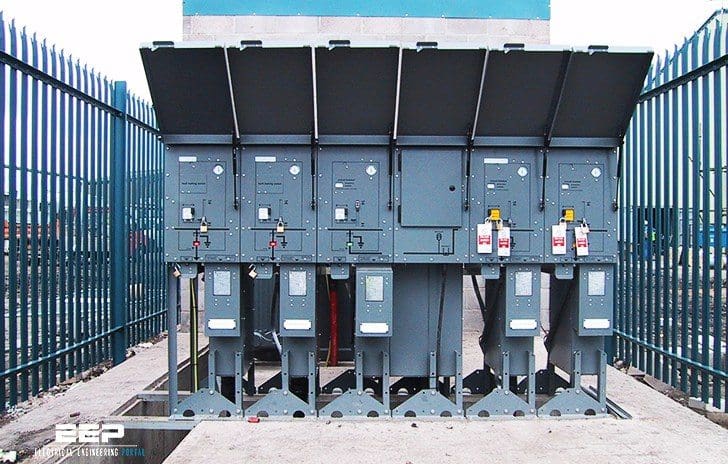
An example of a three-phase power distribution network is illustrated in Figure 1 below.
3-Phase Power Distribution Network
Distribution voltages in continental Europe are typically 110 kV, 69 kV and 20 kV, but practice varies from country to country. In the USA, voltages of 138 kV, 115 kV, 69 kV, 34.5 kV, 13.2 kV and 4.16 kV are employed.
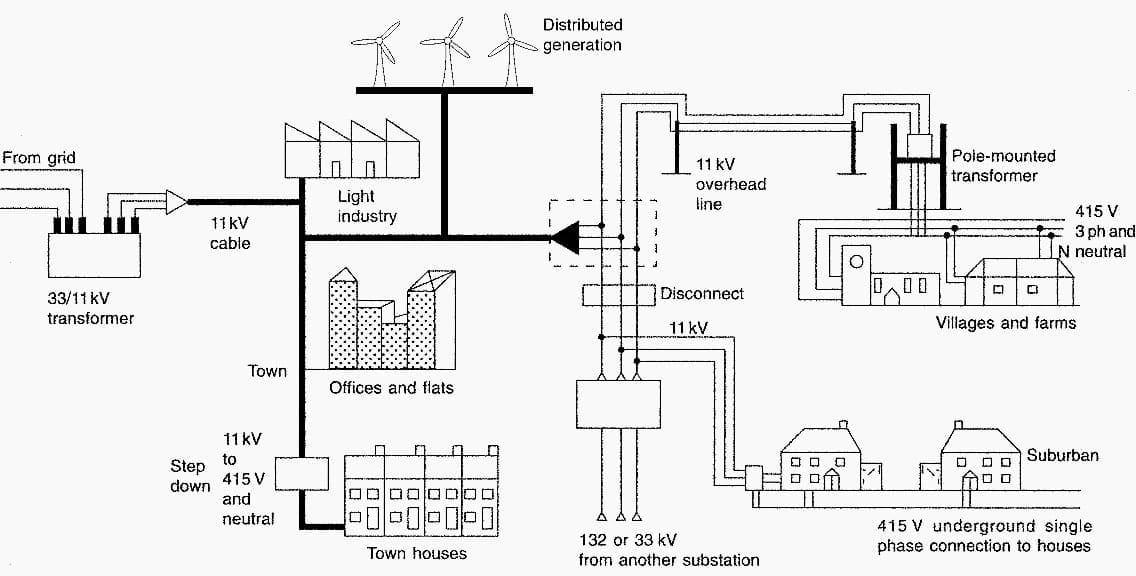

Transformers
The transformer stepping down from the primary distribution to the low voltage supply may be pole-mounted or in a substation, and it is close to the consumers in order to limit the length of the low voltage connection and the power losses in the low voltage circuit.
In a national power system, many thousands of transformers and their associated circuit breakers or fuses / protective devices are required for distribution to low voltage circuits, in contrast to high-voltage transmission and primary distribution systems, where the number of substations is in the hundreds.
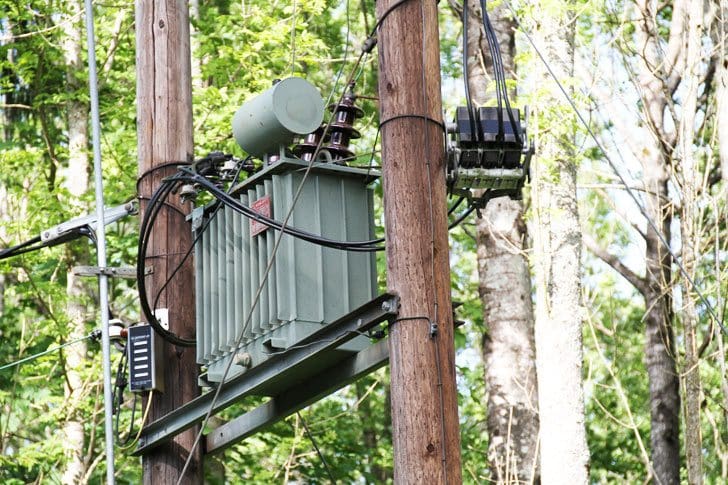

The progressive introduction of small-scale distributed generation (DG) is now a major issue for distribution networks.
It will be noted from Figure 1 that the primary and low voltage distribution systems are connected in a radial configuration. Circuit loops between adjacent substations are avoided because these can lead to circulating currents, which may increase the power losses and create difficulty in protection schemes.
However, tie circuits between adjacent lines and cables are available to reconfigure the network when a portion of the low voltage circuit is out of service for maintenance or because of failure.
These tie circuits are controlled by a normally open switch which can be closed manually within a few minutes, although an increasing trend is for automation of this operation by Supervisory Control and Data Acquisition (SCADA) systems.
Urban and suburban areas
In urban and suburban areas, much of the primary and low voltage distribution system is underground, with readily accessible substations sited in cellars or on small secure plots. Industrial sites may also have a number of substations incorporated into buildings or secure areas.
These may be controlled by the works engineer or operated and maintained by an electricity distribution company.
Rural areas
In rural areas and in more dispersed suburban areas, many three-phase overhead lines operating at 10-15 kV or 27-33 kV are supported for many miles on poles which may be of wood, concrete or steel lattice. The 380–415 V three-phase supply is taken from these lines through a small pole-mounted fused input/output transformer.
If the maximum load to be taken is below about 50 kW, the supplies for homes or farmsteads may be derived from a single-phase 10–15 kV supply.
Typically, a rural primary distribution system supplies up to 50 step-down transformers spread over a wide region. The lines in such a system are vulnerable to damage by tree branches, snow and ice accumulation and lightning strikes and it therefore has lower reliability than underground systems in urban areas.
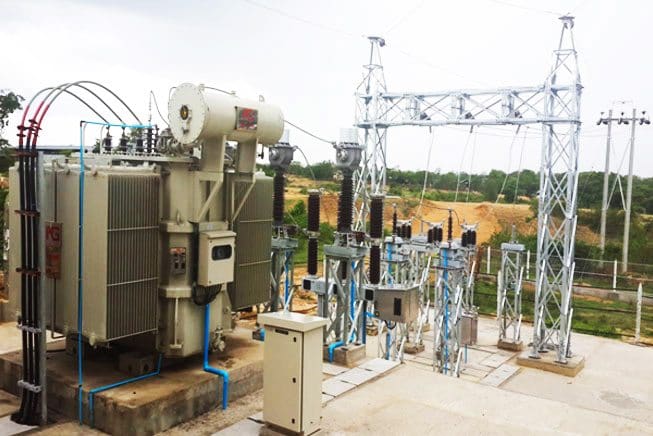

Considerable ingenuity has been applied to protection of this type of system with the use of auto-reclosing supply circuit breakers and automatic reconnection switches.
Repairs to the low voltage system are still dependent, however, on consumers notifying a loss of supply.
Earthing of distribution systems
The proper earthing of distribution systems is of prime importance in order that excessive voltages do not appear on connections to individual consumers.
It is the practice in UK and some other countries to connect to earth the neutral conductor of the four-wire system and the star point of the low voltage winding on the step-down transformer, not only at the transformer secondary output, but also at every load point with a local meter and protective fuse.
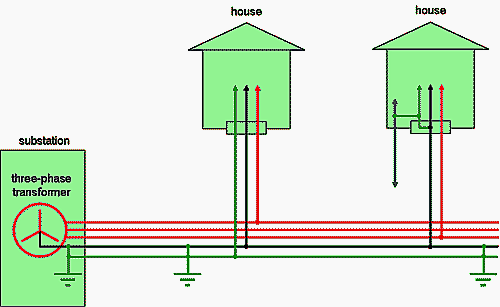

This is known as the Protective Multiple Earth (PME) system, which is designed to ensure that all metallic covers and equipment fed from the supply are bonded so that dangerously high voltages do not hazard lives.
Reference: Newnes Electrical Power Engineer’s Handbook – D.F. Warne (Purchase hard copy from Amazon)








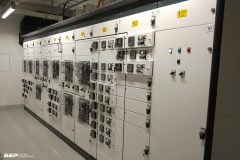


Hello Dear all Members of the Group.
please add me in your group members.
I’m Electrical engineers from Ethiopia.
Thank Edvard, your article on power distribution is very concise and easy to understand even for a non electrical engineering person like me that works in electrical engineering industry.
Thank you for sharing this invaluable knowledge!
Olatunji Adeyemi
from Abu Dhabi, UAE
hello guys how are you? i am fine and i written this message from Ethiopia electrical and computer engineering department and i will ask you one introduction electrical distribution network review paper design figure Microsoft vision word! please! help me guys
Above explanation is a captivating picture of the power flow to the consumer for the young engineers’ attention. It contains alot field experiences and design information. We appreciate your kind effort because it will go a long way…. Thank you very much.
Thanks alot Eng. Edvard for always providing us with the best Electrical Engineering Resources and we appreciate you so much for all your efforts in making sure that everything here is updated and true,
Be blessed so much.
I rank you excellent in making this a right place for us all to obtain quality knowledge and skills,
Thanks alot,
Merry Christmas to everyone here,
Thank you for this article it is so helpful .
Really great and big thanks to Mr Edvard. It hellped me alot
Great article. This is really helpful. We recently wrote about pin and sleeve as it relates to power distribution in a three phase system.
Thanks a lot Edvard. U r really doing a great job. Sharing knowledge in a simple and effective way and it helps a lot of aspiring engineers in the world. Keep the good work. U r a teacher for many. Respect ??
Great, practical and handy articles Edvard. Thank you, Johann Myburgh, Auckland, New Zealand
Thank you Johann.
Moi personnellement j’ai vos performances ,car cela me ramène à réussiccité là technologie numérique qui est dans moi
Thanks for writing this article, nice clear information with helpful videos.
I,m really enjoying the articles and especially the video presentations.I have recently got into needing to know electrical theory and its uses as I,m from a mechanical background so easy to understand from beginner level is very useful. Please keep up the great work.